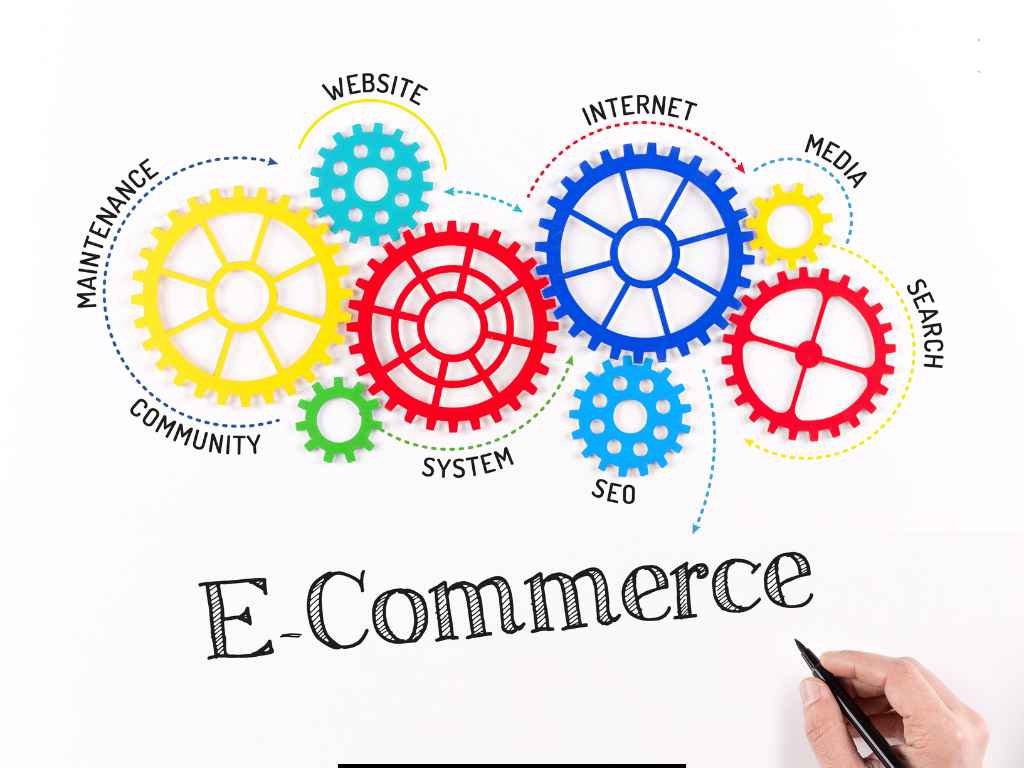To craft an outstanding ecommerce mobile app, concentrate on seamless user experience through integrating innovative features and engaging design elements. Prioritize mobile optimization, user engagement, and interactive elements to create a dynamic shopping experience. Personalized suggestions and streamlined checkout processes are vital for improving user satisfaction and boosting conversions. Keep it simple, with intuitive navigation and consistency in design elements, ensuring a responsive and user-friendly interface. Remember, fast loading speeds, clear CTAs, and personalized experiences are essential for success. Harmoniously blending these elements, you’ll create an exceptional ecommerce app that users will adore.
Key Takeaways
- Prioritize user-friendly interface for seamless navigation.
- Incorporate personalized product recommendations for user engagement.
- Ensure secure payment gateway for trust and reliability.
- Optimize for mobile responsiveness across devices.
- Test thoroughly for intuitive design and functionality.
Understanding Ecommerce Mobile App Design Basics

When delving into the world of ecommerce mobile app design, understanding the fundamental basics that lay the groundwork for a successful user experience is key. In the field of ecommerce app design, optimizing for mobile devices is essential. Users anticipate smooth navigation and fast load times on their smartphones. User engagement plays a significant role in the success of an ecommerce app. Through integrating interactive elements, personalized recommendations, and streamlined checkout processes, you can improve user satisfaction and increase conversion rates.
To excel in ecommerce app design, concentrate on developing a visually attractive interface that is user-friendly and easy to navigate. Use data-driven insights to comprehend user behavior and preferences, allowing you to customize the app to effectively meet their requirements. Keep in mind, in the mobile ecommerce world, every tap and swipe counts. Prioritizing user experience and continuously improving your app based on data analytics can result in a high-performing ecommerce mobile app that enhances user engagement and optimizes conversion rates.
Why Good Design Matters in Ecommerce Mobile Apps?

To thrive in the competitive landscape of ecommerce mobile apps, emphasizing the significance of good design is paramount. A well-crafted user interface is essential for providing a seamless shopping experience to your customers. When users navigate your app effortlessly, finding what they need becomes a breeze, leading to increased satisfaction and loyalty. Additionally, incorporating personalized product recommendations based on user behavior enhances engagement and drives sales.
App design excellence goes beyond aesthetics; it impacts functionality and overall user experience. Focusing on intuitive layouts, clear navigation, and visually appealing elements, you create a platform that users enjoy interacting with. Remember, users are more likely to return to an app that not only offers quality products but also delivers a pleasant and personalized shopping journey. Investing in good design sets the foundation for building strong relationships with your customers and differentiates your app in a crowded market.
Key Principles of Effective Mobile App Design

Crafting an outstanding mobile app design involves adhering to key principles that prioritize user experience and functionality. When designing for mobile users, simplicity is essential. Make sure that your app UI design is intuitive and easy to navigate, eliminating any unnecessary clutter that could confuse users.
A user-friendly interface is vital for keeping your audience engaged and satisfied. Consistency in design elements such as colors, fonts, and buttons across the app contributes to a cohesive and seamless user experience.
Consider the importance of responsiveness in mobile app design. Your app should adapt effortlessly to different screen sizes and orientations, providing a smooth experience on various devices. Prioritize loading speed and minimize the need for excessive data input to streamline user interactions. Conduct thorough testing to identify any usability issues and make necessary adjustments to enhance the overall user experience.
Essential Features Every Ecommerce Mobile App Must Have
To ensure the success of your ecommerce mobile app, integrating essential features is necessary. When it comes to e-commerce app design, key features play an important role in providing a seamless user experience and ensuring best app functionality. One essential feature is a user-friendly interface that makes navigation intuitive and shopping a breeze.
Include a secure payment gateway to build trust with customers and facilitate easy transactions. Implement a search bar to enable users to quickly find products they are seeking. Another significant feature is push notifications to keep users informed about promotions, discounts, and order updates. Integrating a wishlist or favorites option allows users to save items for future purchase, enhancing their shopping experience. Lastly, incorporating social media sharing capabilities can broaden your app’s reach and attract new customers. Through prioritizing these key features, you can create an e-commerce mobile app that is both user-friendly and optimized for success.
How User Experience Impacts Ecommerce App Success?

How does the user experience impact the success of an ecommerce app? A seamless and intuitive user experience is paramount for the success of any ecommerce app. When designing your app, every decision should revolve around enhancing the user experience to drive engagement, retention, and ultimately, conversions. Here’s a breakdown of how user experience influences ecommerce app success:
| User Experience | Impact on Ecommerce App Success |
|---|---|
| Intuitive Navigation | Easy navigation enhances user satisfaction and encourages exploration of products. |
| Fast Loading Speed | Quick loading times reduce bounce rates and improve user retention. |
| Mobile Responsiveness | Ensuring a responsive design across devices increases accessibility and user engagement. |
| Clear CTAs | Well-placed and visible call-to-action buttons guide users towards desired actions, boosting conversions. |
| Personalization | Tailoring the user experience based on preferences leads to increased customer loyalty and repeat purchases. |
Top Trends in Ecommerce Mobile App Design

User experience remains a cornerstone of successful ecommerce app design, driving user engagement and conversions. In 2024, staying ahead with design trends is essential for your mobile app’s success. Embracing dark mode, which reduces eye strain and battery consumption, is a popular choice. Personalized user interfaces tailored to individual preferences enhance engagement. Integrating augmented reality for immersive product experiences sets your app apart.
Enhancements in e-commerce functionality like instant checkout options and secure payment gateways streamline the user journey. Minimalistic designs with intuitive navigation simplify the user experience.
Leveraging AI for personalized recommendations and chatbots for instant customer support boosts user satisfaction. Implementing voice search capabilities enhances accessibility for users on-the-go. Keeping up with these trends guarantees your app remains competitive and user-centric in the dynamic e-commerce landscape of 2024.
5 Common Mistakes to Avoid When Designing an Ecommerce Mobile App
When designing your ecommerce mobile app, avoid overcomplicated navigation that can confuse users. Prioritize mobile responsiveness as a top concern to cater to the increasing number of mobile shoppers. Don’t forget to collect and apply user feedback to improve the app experience, preventing slow load times and a lack of personalization.
1. Overcomplicated Navigation
Exploring an ecommerce mobile app should be intuitive and seamless, guiding users effortlessly through their shopping journey. One critical mistake to avoid is overcomplicating the navigation. A user-friendly design focuses on intuitive navigation, ensuring that customers can easily find what they are looking for without getting lost in a maze of menus.
When designing your ecommerce app, prioritize intuitive design elements that enhance the mobile user experience. Avoid cluttered interfaces and excessive menu options that can overwhelm users. Instead, opt for a clean and organized layout that streamlines the navigation process. Utilize clear categories, filters, and search functionalities to help users locate products quickly.
2. Ignoring Mobile Responsiveness
To create a successful ecommerce mobile app, one must not overlook the essential aspect of mobile responsiveness. Ignoring mobile responsiveness can lead to a poor user experience on different screen sizes, causing elements to appear distorted or out of place on various app screens. When designing your app, make sure that spacing and layout adapt seamlessly to different devices to provide a consistent and user-friendly interface.
Mobile applications that lack responsiveness may frustrate users and result in lower engagement and conversion rates. Incorporating responsive design principles, such as flexible grids and images, you can optimize the app’s performance across a range of devices. Prioritize testing your app on various screen sizes to guarantee a seamless user experience regardless of the device used.
3. Neglecting User Feedback
Neglecting user feedback is a crucial misstep that can hinder the success of your ecommerce mobile app. User feedback is a goldmine of insights that can guide you in enhancing customer satisfaction and boosting customer engagement. By overlooking this valuable resource, you risk missing out on vital information that could lead to improved app functionality and overall user experience.
When you ignore user feedback, you are basically turning a blind eye to the thoughts, preferences, and suggestions of your customers. This can result in a disconnect between what your users want and what your app offers. Customer satisfaction is directly linked to how well you listen and respond to their feedback. Ignoring this aspect can lead to decreased user retention and lower conversion rates.
To avoid neglecting user feedback, make it a priority to actively seek out and listen to what your customers have to say. Implement feedback mechanisms within your app, analyze the data collected, and use it to make informed decisions that prioritize customer satisfaction and drive better customer engagement. Remember, happy customers are loyal customers.
4. Slow Load Times
Amidst the dynamic landscape of ecommerce mobile apps, one common pitfall that can greatly impede user experience is slow load times. When users interact with your app, they expect swift responses and seamless shifts. Slow load times can lead to frustration and abandonment, impacting app performance and user retention. To optimize your app and enhance user experience, focus on improving load times.
Optimizing images and videos can notably reduce load times without compromising visual quality. Compressing files and utilizing lazy loading techniques can expedite content delivery, ensuring a smoother user experience. Moreover, minimizing HTTP requests and leveraging caching mechanisms can further enhance performance.
Regularly monitoring and analyzing app performance metrics can provide valuable insights into areas that require optimization. Utilize tools like Google’s PageSpeed Insights to identify performance bottlenecks and implement necessary improvements promptly.
5. Lack of Personalization
Slow load times can greatly impact user experience, but another critical aspect to consider when designing an ecommerce mobile app is the lack of personalization. Providing personalized shopping experiences is key to engaging users and increasing conversions. Creating user profiles that capture preferences, purchase history, and behavior patterns, you can tailor the app experience to individual needs.
Implement features like personalized offers based on past purchases or browsing history to entice users to make repeat purchases. Providing access to training content related to products of interest can enhance the overall shopping experience and build customer loyalty. Remember, personalization is not just a trend but a necessity in today’s competitive ecommerce landscape. Invest time and resources in understanding your users’ needs and preferences to deliver a truly customized experience that keeps them coming back for more.
10 Advantages of Investing in Quality Ecommerce Mobile App Design
Investing in quality ecommerce mobile app design can greatly enhance your user engagement, leading to increased conversion rates and improved customer loyalty. Through focusing on a well-designed app, you can also boost your brand recognition and create a streamlined shopping experience that keeps customers coming back for more. Quality design isn’t just about looks; it’s about creating a user-centric platform that drives results and fosters long-term relationships with your customers.
1. Enhanced User Engagement
As you navigate the ever-changing terrain of ecommerce, the importance of improved user interaction cannot be exaggerated. Investing in top-notch ecommerce mobile app design can result in increased customer engagement, ultimately enhancing interaction and positively influencing users’ attitude toward businesses. Incorporating user-friendly features, personalized recommendations, and seamless navigation, you can create an engaging experience that keeps customers coming back for more.
Improved user interaction goes beyond just attracting users; it also plays a significant role in streamlining business processes. Through interactive elements, push notifications, and easy checkout processes, you can not only keep users engaged but also increase the efficiency of your operations. By analyzing user data and behaviors, you can continuously refine your app to better cater to your audience’s needs and preferences.
2. Increased Conversion Rates
To truly amplify the impact of your ecommerce mobile app design, it’s imperative to shift the focus towards enhancing conversion rates. Through investing in quality design that prioritizes user experience and engagement, you can boost conversion rates and drive more sales. A seamless shopping experience, intuitive navigation, and personalized recommendations all contribute to creating a positive user journey that culminates in higher conversion rates.
When users have a smooth and enjoyable shopping experience on your mobile app, they are more likely to complete their purchases and return for future transactions. Improving the checkout process, offering secure payment options, and providing excellent customer support within the app can help build trust and loyalty with your customers, leading to increased conversion rates over time.
Data-driven design decisions that are centered around improving the overall user experience can lead to a significant increase in conversion rates. Through analyzing user behavior, feedback, and preferences, you can continuously refine and enhance your ecommerce mobile app to drive conversions and maximize sales.
3. Improved Customer Loyalty
Enhance customer loyalty through a quality ecommerce mobile app design that prioritizes user engagement and satisfaction. Promoting an improved experience through intuitive navigation, personalized recommendations, and seamless checkout processes, you can strengthen your customer relationships. Implementing retention strategies such as push notifications for special offers or discounts can keep users engaged and coming back to your app. Introducing loyalty programs where customers can earn points or rewards for their purchases will further incentivize repeat business.
4. Better Brand Recognition
With a well-crafted ecommerce mobile app, your brand can achieve unparalleled recognition in the digital domain. Enhancing design elements that boost brand recognition, you can create a lasting impression on your users. Here’s how a user-friendly and consistent design can elevate your brand recognition:
- Memorable Visual Identity: Including your brand colors, logo, and other visual elements consistently throughout the app helps users connect these visuals with your brand.
- Unique User Experience: Incorporating innovative design features that distinguish your app from competitors can leave a lasting impression on users, enhancing brand recognition.
- Brand Messaging Integration: Seamlessly integrating your brand’s messaging into the design to reinforce brand values and establish a cohesive brand image.
- Interactive Elements: Involving users with interactive features not only improves user experience but also boosts brand recall and recognition.
5. Streamlined Shopping Experience
Now, let’s shift our focus to the “Streamlined Shopping Experience” and explore the notable advantages that come with investing in a high-quality ecommerce mobile app design. When it comes to user experience, a well-crafted app can offer a seamless and efficient shopping journey. With clear product listings, intuitive navigation, and a simplified checkout process, users can easily find what they are looking for and make purchases without any trouble.
A streamlined shopping experience not only enhances customer satisfaction but also increases the likelihood of repeat purchases. Optimizing app design to prioritize user convenience and satisfaction, businesses can foster loyalty and drive engagement. Investing in a mobile app that emphasizes a streamlined shopping experience demonstrates a commitment to providing value to customers and staying ahead of the competition. Remember, a well-crafted app that focuses on user experience can have a significant impact on your business’s success in the digital marketplace.
6. Higher Sales Revenue
When you invest in a top-notch ecommerce mobile app design, you open doors to a world of opportunities for boosting your sales revenue. Through focusing on a design that enhances the user experience and increases mobile conversion rates, your app can stand out in the competitive app market. Here are some ways investing in quality design can lead to higher sales revenue:
- Increased Conversions: A well-crafted app can guide users smoothly through the sales funnel, resulting in higher conversion rates.
- Enhanced User Experience: A user-friendly interface and easy-to-use design can keep customers engaged and promote repeat purchases.
- Improved Mobile Conversion Rate: Tailoring your app for mobile devices can have a notable impact on conversion rates, as more users are shopping on mobile platforms.
- Collaboration with App Market Parties: Partnering with app market experts can assist you in reaching a broader audience and attracting more customers to your app.
7. Effective Use of Push Notifications
As you continue refining your ecommerce mobile app for peak performance and revenue generation, harnessing the power of push notifications emerges as a strategic advantage worth exploring. Push notifications are a powerful tool in enhancing the e-commerce functionality of your mobile app, allowing you to engage with customers in real-time and provide personalized updates. Utilizing push notifications effectively, you can create a more interactive and seamless customer experience, driving increased user engagement and ultimately boosting sales.
Through targeted push notifications, you can notify users about new products, promotions, or abandoned carts, keeping your brand at the forefront of their minds. These personalized messages can greatly impact customer retention and repeat purchases, as they enhance the overall shopping experience for your users. Analyzing user data and behavior, you can tailor these notifications to individual preferences, maximizing their effectiveness.
Incorporating push notifications into your mobile app design not only improves customer engagement but also helps in building brand loyalty and driving conversions. Embrace this powerful tool to elevate your e-commerce mobile app and create a more tailored and engaging customer experience.
8. Access to Valuable User Data
During the digital age, the design of your ecommerce mobile app plays a pivotal role in granting you access to valuable user data. Investing in quality app design, you can extract insights that drive your business forward. Here’s how you can leverage this data to enhance your ecommerce platform:
- Personalized User Experiences: Utilize user data to tailor recommendations and offers, providing a more personalized shopping journey.
- Behavior Analysis: Access valuable insights into user behavior patterns, allowing you to optimize your app for better engagement.
- Targeted Marketing Campaigns: Leverage user data to create targeted marketing campaigns that resonate with your audience, increasing conversion rates.
- Enhanced Customer Support: Understand user preferences and pain points through data analysis, enabling you to offer proactive customer support.
9. Multi-channel Integration
Investing in quality ecommerce mobile app design opens up a world of opportunities for multi-channel integration that can revolutionize your business strategy. Integrating various channels such as your website, social media platforms, and physical stores with your mobile app, you create a seamless shopping experience for your customers. This integration allows for a consistent brand experience across different touchpoints, enhancing customer loyalty and engagement.
With multi-channel integration, you can leverage e-commerce functionality on your mobile app to provide customers with a convenient shopping experience right from their mobile screens. Offering a variety of payment options within the app further improves the user experience and encourages more purchases. Streamlining the buying process and providing secure payment gateways, you can increase conversions and drive revenue.
10. Competitive Edge in the Market
Seeking a competitive edge in today’s market requires staying ahead of the curve with a quality ecommerce mobile app design. To achieve this, investing in user-friendly design and custom development can set your app apart from the competition. Here’s how you can gain a competitive edge with advanced features:
- User-Friendly Design: Prioritize intuitive user interfaces and seamless navigation to enhance the shopping experience.
- Custom Development: Tailor the app to meet the specific needs of your target audience, offering personalized features and services.
- Competitive Edge: Stay updated with market trends and analyze competitors to identify opportunities for differentiation.
- Advanced Features: Incorporate cutting-edge technologies like AI recommendations, AR/VR experiences, or one-click checkout to provide a unique and engaging shopping journey.
How to Plan Your Ecommerce Mobile App Design Strategy?
Crafting a successful ecommerce mobile app design strategy entails thorough planning and a profound understanding of your target audience’s preferences and behaviors. To create a user-friendly design, maintaining app design consistency across all screens and features is key. Initiate the process with in-depth research to identify your target audience’s needs, preferences, and pain points. Utilize this data to guide the design decisions, such as color schemes, navigation flow, and feature placement. Prioritize simplicity and intuitive interactions to enhance user experience and drive engagement.
When strategizing your ecommerce mobile app design, consider integrating innovative features that differentiate your app from competitors. Brainstorm distinctive functionalities that address your audience’s specific needs while reflecting your brand identity. Furthermore, utilize data analytics to track user behavior within the app and make informed design adjustments based on user interactions.
The Role of A/B Testing in Ecommerce App Design
When optimizing an ecommerce mobile app’s design for maximum user engagement and conversion rates, harnessing the power of A/B testing is essential. A/B testing allows you to experiment with different design elements and functionalities to determine what resonates best with your users. Here’s why A/B testing is necessary in ecommerce app design:
- Optimizing User Experience: A/B testing helps you fine-tune the user experience by testing different layouts, features, and navigation paths to identify what works best for your target audience.
- Enhancing Functionality: By testing various functionalities such as checkout processes, search filters, or product displays, you can refine the app’s functionality to meet user expectations.
- Improving Conversion Rates: A/B testing enables you to identify and implement changes that drive higher conversion rates, ultimately leading to increased sales and revenue.
- Data-Driven Decisions: Utilizing A/B testing allows you to make informed decisions based on real user data rather than assumptions, ensuring that your design changes are supported by evidence.
Key Metrics to Measure the Success of Your Ecommerce App
To gauge the effectiveness of your ecommerce mobile app, it is essential to track key metrics that provide insight into its performance and user engagement. Monitoring key metrics is necessary for optimizing user experience and ensuring that your app meets design requirements. One vital metric to focus on is app conversion rate, which indicates the percentage of users who take a desired action, such as making a purchase. When analyzing this metric, you can identify areas for improvement in your app’s design and user flow to increase conversions.
Additionally, tracking metrics related to user engagement, such as session duration, bounce rate, and retention rate, can provide valuable insights into how users interact with your app. These metrics help you understand user behavior, preferences, and pain points, allowing you to make data-driven decisions to enhance the overall user experience.
How MohitEcommerce Can Help with Your Ecommerce Mobile App Design?
As you aim to optimize your ecommerce mobile app design and enhance user engagement, partnering with MohitEcommerce can be a game-changer. MohitEcommerce specializes in creating cutting-edge e-commerce apps using React Native, guaranteeing a seamless and engaging user experience. Here’s how MohitEcommerce can assist you in achieving your app design goals:
- Expertise in React Native: Leveraging the power of React Native, MohitEcommerce can develop a high-performance app compatible with both iOS and Android platforms.
- Stunning Inspirational Designs: Their team of designers excels in creating visually appealing and user-friendly interfaces that inspire and captivate users.
- Cost-Effective Application Development: MohitEcommerce offers competitive pricing options without compromising on quality, helping you manage application development costs effectively.
- Focus on User-Centric Solutions: With a user-focused approach, MohitEcommerce guarantees that the app design meets the needs and preferences of your target audience, enhancing user satisfaction and retention.
Partnering with MohitEcommerce can elevate your e-commerce mobile app to new heights, providing a competitive edge in the digital marketplace.
The Importance of User Research in Mobile App Design
User research stands as a cornerstone in the field of mobile app design, driving innovation and ensuring user-centric solutions. Conducting thorough user research is essential to understand the needs, preferences, and behaviors of your target audience. Gathering insights through methods like surveys, interviews, and usability testing, you can create a mobile app that is not only visually appealing but also highly functional and intuitive.
| User Research Methods | Benefits |
|---|---|
| Surveys | Collect quantitative data on user preferences |
| Interviews | Acquire qualitative insights into user needs |
| Usability Testing | Pinpoint usability issues for improvement |
| Heatmaps | Visualize user interactions for optimization |
| A/B Testing | Evaluate different app versions for user preferences |
User research helps in designing a mobile app that is contextually pertinent to users, leading to higher user satisfaction and engagement. Incorporating insights from user research, you can customize your mobile app to meet the specific needs of your target audience, ultimately resulting in a more successful app design.
Incorporating Visual Elements for Maximum Impact
Having laid a strong foundation through thorough user research, the next phase in designing an ecommerce mobile app involves integrating visual elements strategically to create maximum impact. When it comes to incorporating visual elements for maximum impact, you need to focus on the following key aspects:
- Product Showcase: Utilize high-quality images and videos to showcase your products effectively, helping users make informed purchasing decisions.
- Development of Interactive Features: Implement interactive elements like 360-degree product views or swipe gestures to enhance user engagement and create a memorable shopping experience.
- Color Scheme Selection: Choose a cohesive color palette that reflects your brand identity and creates a visually appealing interface for users.
- Visual Hierarchy: Establish a clear visual hierarchy by emphasizing important elements such as product categories or special offers, guiding users through the app effortlessly.
Understanding the Importance of App Performance and Speed
Optimizing your ecommerce mobile app’s performance and speed is crucial in guaranteeing a seamless user experience. When designing your app, keep in mind that users expect quick loading times and smooth navigation. Slow performance can lead to frustration and abandoned carts, impacting your conversion rates. To emphasize the importance of app performance and speed, consider the following factors:
| Factors | Description | Impact |
|---|---|---|
| Loading Times | Faster loading times lead to higher user engagement and retention. | Improved User Experience |
| Responsiveness | A responsive app guarantees users can quickly interact with the interface. | Enhanced User Satisfaction |
| Stability | A stable app decreases the likelihood of crashes or errors, providing a seamless experience. | Increased User Trust |
| Network Efficiency | Optimizing for varying network speeds ensures consistent performance for all users. | Broad User Accessibility |
| Resource Management | Efficient resource allocation enhances app speed and prevents lagging or delays. | Smooth User Interactions |
Creating a Seamless Checkout Process in Your Ecommerce App
Enhance your ecommerce mobile app’s conversion rates and customer satisfaction through prioritizing a streamlined checkout process. A seamless checkout experience is essential for retaining customers and encouraging repeat purchases. Here’s how you can optimize your ecommerce app’s checkout process:
- Simplify Form Fields: Reduce the number of required fields to speed up the checkout process and minimize user input.
- Guest Checkout Option: Offer a guest checkout feature to allow users to make purchases without creating an account, reducing barriers.
- Multiple Payment Options: Provide a variety of payment methods such as credit/debit cards, digital wallets, and buy now, pay later services for user convenience.
- Real-Time Order Tracking: Keep customers informed by offering real-time updates on their order status, enhancing transparency and trust in your app.
Best Practices for App Maintenance and Updates
To ensure your ecommerce mobile app remains competitive and user-friendly, implementing best practices for app upkeep and updates is vital. Ongoing upkeep is necessary to guarantee your app functions smoothly and stays bug-free. Regularly updating your app not only enhances its performance but also improves security and user experience.
Monitoring user feedback and app analytics can provide valuable insights for prioritizing upkeep tasks and updates. Addressing issues promptly and staying proactive with app upkeep can help prevent potential downtime and keep your users satisfied.
Utilizing automated tools for monitoring app performance and conducting regular tests can streamline the upkeep process. Moreover, staying informed about the latest trends and technologies in app development can help you make informed decisions regarding updates. Remember, app upkeep is an ongoing process that requires dedication and attention to detail to keep your ecommerce mobile app at its peak.
Preparing for The Future of Ecommerce App Design
As your ecommerce mobile app continues to evolve and adapt to meet user demands, it’s crucial to look ahead and anticipate the future of app design. To ensure your app remains competitive and user-friendly, consider the following key aspects:
- Enhanced User Experiences: Focus on creating seamless and personalized experiences for your users to increase engagement and satisfaction.
- Innovative App Design: Stay updated on the latest design trends and technologies to keep your app visually appealing and modern.
- Advanced Ecommerce Functionality: Integrate new features and functionalities that streamline the shopping process and enhance overall user convenience.
- Diverse Payment Options: Offer a variety of secure and convenient payment methods to cater to different user preferences and increase conversion rates.

